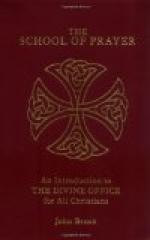This Curial Breviary was adopted by the Franciscans in their active lives. They changed the text of the Psalter only, Psalterium Romanum, to the more approved text, the Psalterium Gallicanum. The improved Curial Breviary was imposed on the churches of Rome by the Franciscan Pope, Nicholas III. (1277-1280), and henceforth it is called the Roman Breviary. Thus we see that the book used daily by priests got its name in the thirteenth century, although the divine office is almost from Apostolic times.
But liturgy is a progressive study, a progressive practice capable and worthy of perfecting. And the friars strove for the greater perfection and beauty of the new Breviary. They added variety to the unity already achieved and yet did not reach liturgical perfection nor liturgical beauty. They loaded the Breviary by introducing saints’ days with nine lessons, thus avoiding offices of three lessons. And by keeping octave days and days within the octave as feasts of nine lessons, they almost entirely destroyed the weekly recitation of the psalter; and a large portion of the Breviary ceased to be used at all. The Franciscan book became very popular owing to its handy form. Indeed its use was almost universal in the Western Church. But the multiplication of saints’ offices, universal and local, no fixed standard to guide the recital, and the wars of liturgists, made chaos and turmoil.
Liturgical reform became an urgent need. Everyone reciting the canonical hours longed for a great and drastic change. The Humanists, Cardinal Bembo (1470-1549), Ferreri, Bessarion, and Pope Leo X. (1513-1521) considered the big faults of the Breviary to lie in its barbarous Latinity. They wished the Lessons to be written In Ciceronian style and the hymns to be modelled on the Odes of Horace. Ferreri’s attempt at reforming the Breviary dealt with the hymns, some of which he re-wrote in very noble language, but he was so steeped in pagan mythology that he even introduced heathen expressions and allusions, His work was a failure. The traditional school represented by Raoul of Tongres, Burchard, Caraffa, and John De Arze loved the past with so great a love that they refused to countenance any notable reforms, A third school, the moderate school, was represented by Cardinal Pole, Contarini, Sadolet and Quignonez, a Spanish




